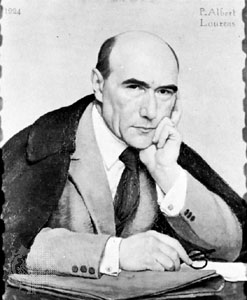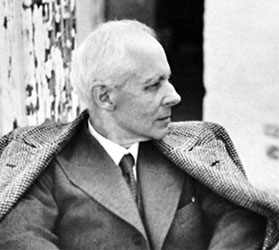HRS 166 – THE MODERN TEMPER
George S. Craft
Spring 2002
Tahoe Hall 3088; 278-6400; gcraft@csus.edu
Office Hours: W 2:00-3:30 am; R 9:00-10:30 pm
Catalog
Description: The Modern Temper. An investigation of those crises in
art and society underlying the development of anti-humanism in the 20th century.
3 units. (Course listed in
General Education Area C4)
Course
Description: This course will introduce you to the arts and
humanities in Europe in roughly the first half of the 20th century.
We will concentrate primarily on imaginative literature (short novels and
novellas), painting and music (opera and the orchestra); we may also look at a
little poetry and architecture. We
will have a broad geographic scope: England (Woolf), France (Gide and Camus),
Germany (Mann), the Austrian Empire (Kafka) and Russia (Tolstoy). The
course will begin in the pre-modernist period around 1880 and end around 1940 at
the beginning of the Second World War. The
various works we study will be bound together by the main ideas and attitudes
reflecting the social and political conditions of the early 20th
century.
European history in this period is characterized by brilliant successes
combined with irrationality, upheaval, inhumanity and uncertainty. At the end of the 19th century artists and writers
seemed to be disillusioned with the secular, liberal and progressive assumptions
in place since 1815. Industrialism
and urbanization placed millions of people in strange cities performing
mechanical routines and subjected to impersonal bosses and an ever more powerful
state. Artists and writers were
often uncertain of how to make a living and were alienated from the bourgeois
society and culture around them (bohemianism).
Their suspicions were confirmed by total war (World War I) and economic
crisis (The Great Depression).
“Modernist” culture reflects this alienation and uncertainty. The term ‘modernism’ was applied first to literature
where writers “gave free rein to complicated, sometimes baffling but often
lyrically stunning explorations of their inner states…. [in] the labyrinthine
passages of the unconscious where dream fragments, sensations, and fantasies
proceed in no fixed order.” (Winders, European
Culture Since 1848) Painters
abandoned the “glue” of visual reality and Renaissance naturalism and
indulged in a variety of “modernist” styles that had nothing in common
except for a renunciation of the visual object.
Music composers also disavowed many of their traditions including the
tonal system and embarked on bold creative experiments that alienated much of
the listening public. Modernism
requires that we abandon the notion that a work of art must be “beautiful.”
This era produced brilliant and interesting works of art. It is our undertaking to learn to appreciate them, and to
make some personal sense out of 20th century culture.
Course
Objectives: HRS
166 has several objectives:
1) Enhance your
appreciation of some of the great works of western humanities (literature, art
and music) in the early 20th century.
2) Develop your
insight into the human condition as experienced in the 20th century.
What does it mean to live in the ‘modern’ age?
3) Investigate the literary concept of
‘modernism’ and see if it applies to other branches of the arts and
humanities.
4) Understand the interrelatedness of literature,
music and the visual arts in the context of any civilization.
5) Develop your (and my) skills of analysis, critical thinking and
English composition.
Required
Readings: The following required books are available in the Hornet
Bookstore. You don’t have to
purchase the books in any particular edition.
Leo Tolstoy, The Death of Ivan
Ilyich (1882)
André Gide, The Immoralist (1902)
Franz Kafka, The Transformation (1905)
and In the Penal Colony (1917)
Thomas Mann, Death
in Venice (1911); perhaps Tristan (1902);
and Mario and the Magician (1929)
Virginia Woolf,
Mrs. Dalloway (1925)
Albert Camus, The
Stranger (1942)
Rosemary
Lambert, Cambridge Introduction to the
History of Art: The Twentieth Century (1981). This book has short discussions of 20th century
art. It would be helpful for
students with little familiarity with the subject.
It is not required.
You will also receive short
dittoed handouts relating to course materials.
Keep a three-ring loose-leaf binder for these handouts. We may view some video programs in or out of class, e.g. on
modern architecture. Some internet
resources are useful; I would particularly recommend www.sparknotes.com,
which has in-depth discussions of most of our assigned readings
Classroom Procedure
Most of class time will be devoted to lectures and a structured
discussion of the assigned texts. I
will give you precise reading assignments accompanied by study lists when
possible. I expect you to have the
reading done by the day of the assignment.
Participation in class discussions in important, especially since this is
a small class. I will divide you up
into “discussion teams” of two students for the reading assignments.
Students will be expected to read the assigned material carefully and to
help lead the discussion with questions, answers, and informed comments.
Student members of a team should stay in touch with one another.
Your final grade may be marginally raised or lowered by your discussion
performance.
As most of the learning in this class will probably occur in class, I
expect all of you to attend class regularly – at least 85% of the time. You may lose up to one full grade point (e.g., B to C) by
poor attendance.
I will try to put course materials on the web under HRS 166; they would
be accessed from my faculty webpage and from the HRS and History Departments
webpages.
I will be available in my office
during my office hours and by appointment if you are unable to come by during
office hours. Please feel free to
email me for questions/discussion; I am pretty good about answering email
messages, and once you get me going, I love to talk to students about these
materials. So that you may stay in
touch with one another, I will distribute a list of email addresses of students
enrolled in this course.
I must emphasize: in this course
attending class is very important.
Testing, Writing and Grading
Writing is very important in this course.
You will be assigned three thought papers spaced at equal intervals,
about every five weeks. The last
paper will be due the date of the final exam.
Each paper will be about five (5) standard typewritten pages or the
equivalent in legible, double-spaced longhand.
Expect thus to write about 4000 words.
These essays will be critical thought papers, the topics being chosen
from a list of essay questions distributed about two weeks before the due date.
The grade I assign your paper will be affected by both content
(depth, inventiveness, cohesiveness of your ideas) and writing style (correctness, clarity and elegance).
For further instructions consult the Guidelines
for Writing Thought Papers that I will distribute to your shortly.
I encourage you to consult with me ahead of time about choosing paper
topics of particular interest to you.
You will also have two identification style examinations, one in
mid-semester and the other on the final exam date.
They will test basic information and insights covered in class
discussions and readings. I will
give you study lists to prepare these examinations.
Your final grade will be calculated as follows:
Main essays @20% each 60%
Two ID exams @20%
40%
___________________________________
Total
100%
Of course, your final grade may be significantly affected by your class
participation and especially by your attendance.
Send problems, comments or
suggestions to: gcraft@csus.edu
Return to Department of History
California
State University, Sacramento


